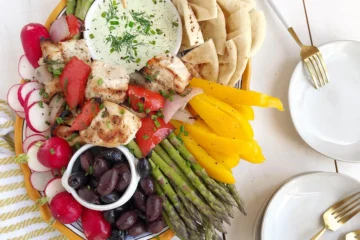Healthy kitchen sink cookies made with oat flour, coconut sugar & dark chocolate—chewy, wholesome, and guilt-free indulgence in every bite.

Introduction: healthy kitchen sink cookies
Fast forward a few years, and my metabolism isn’t quite the enthusiastic friend it used to be. I still love that “everything but the kitchen sink” vibe, but now I want my cookies to be a little kinder to my body. That’s how this healthy kitchen sink cookies recipe was born—still decadent and satisfying, but made with ingredients you can feel good about.
The first time I made kitchen sink cookies, I was in college, armed with a mixing bowl and absolutely no self-control. I dumped in chocolate chips, pretzels, leftover granola—basically anything I could find in my pantry—and somehow, the result was magic.
Why Make a Healthier Version?
Don’t get me wrong—traditional kitchen sink cookies are a nostalgic joy. But they’re also loaded with refined sugar, white flour, and enough butter to make your nutrition goals cry.
The good news? With a few smart swaps, you can:
- Keep the texture – Soft, chewy, and just a little crispy at the edges.
- Lower the sugar spike – Coconut sugar and dark chocolate give you sweetness without the crash.
- Add nutrients – Oat flour, nuts, and seeds sneak in fiber, protein, and healthy fats.
Basically, you still get all the indulgence—just with a little less guilt.
The Healthier Swaps I Swear By
When I was experimenting with this recipe, I found these changes made the biggest difference:
- Oat Flour Instead of All-Purpose – More fiber, gentle on digestion, and adds a subtle nuttiness.
- Coconut Sugar Instead of White Sugar – Lower glycemic index and a caramel-like flavor.
- Dark Chocolate Chips (70%+ cocoa) – Rich, bold, and way less sugar than milk chocolate.
- Nut Butter for Some of the Butter – Almond or peanut butter adds creaminess and healthy fats.
- Fun Add-Ins – Unsweetened coconut flakes, chopped walnuts, or even pumpkin seeds for texture and nutrition.
My Go-To Healthy Kitchen Sink Cookie Recipe
Servings: About 18 cookies
Prep Time: 15 minutes | Bake Time: 10 minutes
Ingredients
- 1 ½ cups oat flour
- ½ tsp baking soda
- ¼ tsp sea salt
- ½ cup coconut sugar
- ¼ cup nut butter (almond or peanut)
- ¼ cup unsalted butter or coconut oil, softened
- 1 large egg (or flax egg for vegan)
- 1 tsp vanilla extract
- ½ cup dark chocolate chips
- ¼ cup unsweetened coconut flakes
- ¼ cup chopped walnuts or almonds
Instructions
- Preheat your oven to 350°F (175°C) and line a baking sheet with parchment paper.
- In a small bowl, whisk together oat flour, baking soda, and salt.
- In a larger bowl, beat coconut sugar, nut butter, and butter until creamy. Add egg and vanilla, mixing until smooth.
- Gradually stir in the dry ingredients until just combined—don’t overmix.
- Fold in chocolate chips, coconut flakes, and nuts.
- Scoop tablespoon-sized portions onto your baking sheet, spacing them about 2 inches apart.
- Bake for 9–11 minutes, until the edges are golden but the centers are still soft.
- Let them cool for 5 minutes on the baking sheet before moving them to a wire rack.
Calorie Breakdown (Per Cookie)
| Ingredient | Calories | Benefits |
|---|---|---|
| Oat flour (1.5 cups) | 450 | Fiber & whole grain goodness |
| Coconut sugar (½ cup) | 180 | Lower GI than white sugar |
| Nut butter (¼ cup) | 380 | Healthy fats & protein |
| Butter or coconut oil (¼ cup) | 200 | Texture & flavor richness |
| Dark chocolate chips (½ cup) | 320 | Antioxidants & deep cocoa flavor |
| Coconut flakes (¼ cup) | 70 | Natural sweetness & texture |
| Walnuts/almonds (¼ cup) | 200 | Omega-3s & crunch |
Per cookie: About 100–110 calories
Taste Test: Healthy vs. Traditional
I did a little side-by-side taste test with friends, and here’s the verdict:
- Texture: Chewy with just the right amount of bite—oat flour makes them slightly softer than all-purpose.
- Sweetness: Mellow and caramel-like instead of a sugar bomb.
- Flavor: Dark chocolate + nut butter = rich, cozy, and satisfying.
- Winner: Even the “sugar purists” admitted they liked this version just as much, if not more.
Pro Tip
If you’re new to healthy baking, start with a $40–$60 investment in quality baking tools—good measuring cups, a silicone baking mat, and a hand mixer will make this process so much smoother. And trust me, once you taste these cookies, you’ll be making them on repeat.
FAQs About Healthy Kitchen Sink Cookies
Q: Can I make these gluten-free?
A: They already are if you use certified gluten-free oat flour.
Q: Can I freeze the dough?
A: Absolutely—just scoop it into portions, freeze on a tray, then store in a freezer bag for up to 3 months.
Q: Can I make them vegan?
A: Yes! Swap the egg for a flax egg and use coconut oil instead of butter.
Q: Are they still sweet enough without white sugar?
A: Totally—coconut sugar and dark chocolate chips give them a rich, satisfying sweetness.
Q: Can I add other mix-ins?
A: 100%! Pretzels, dried fruit, pumpkin seeds, chia seeds—if it fits the “kitchen sink” vibe, toss it in.
Also Read: How to Make Cevurı at Home: Your Flavor-Packed Mediterranean Adventure



